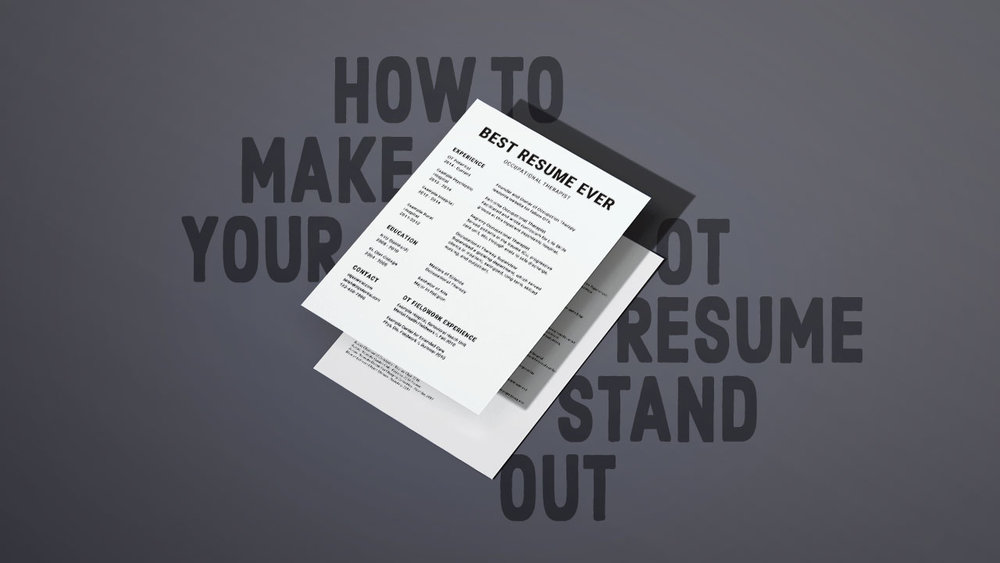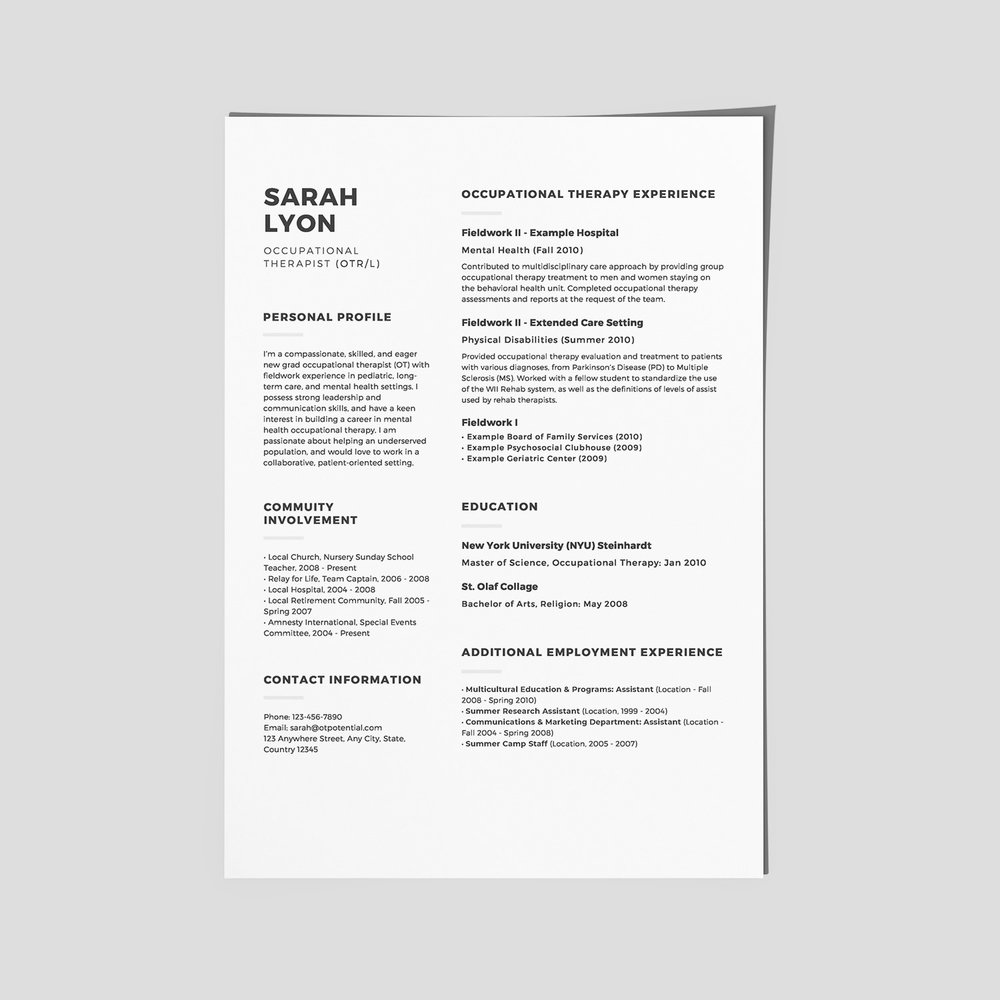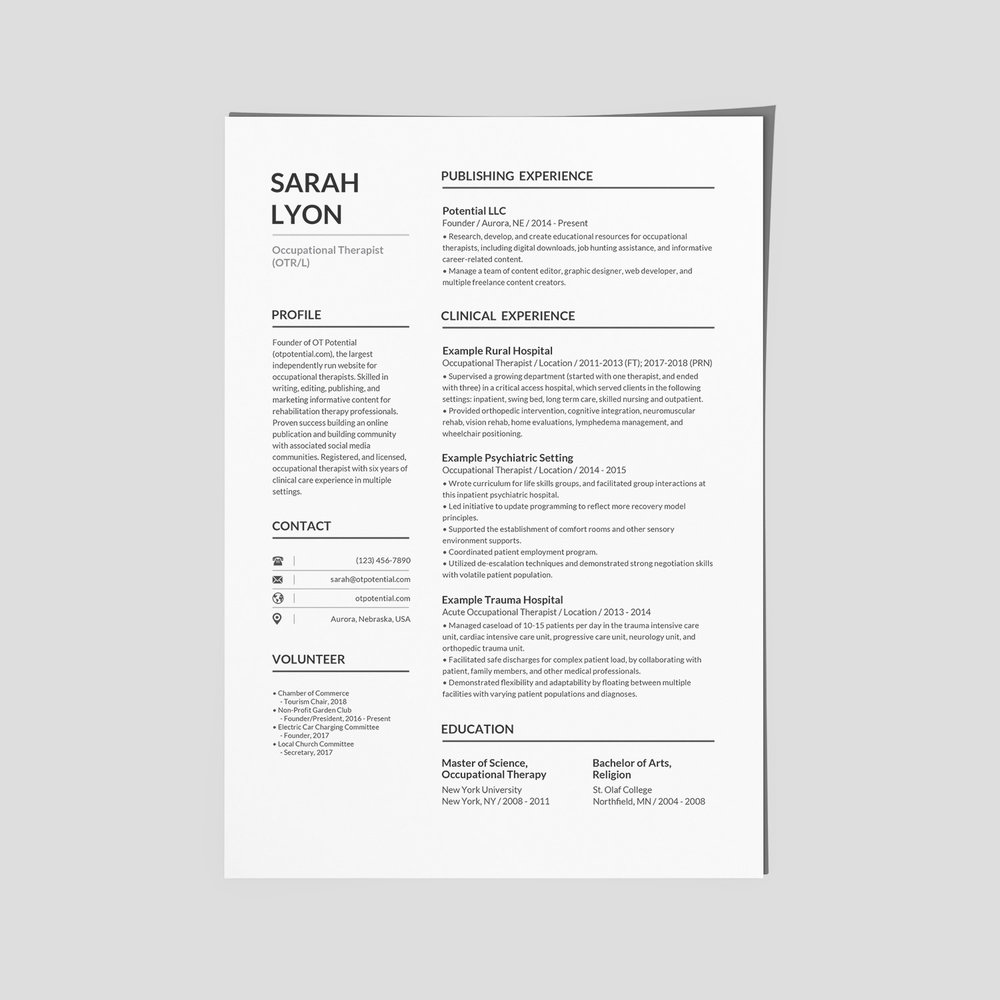

If you’re on the hunt for a new OT job, creating an impressive occupational therapy resume is more important than ever.
With reimbursements tightening and more schools opening, some markets are becoming pretty competitive for OT therapy practitioners—especially if you’re going for the best OT jobs or OTA jobs.
That’s why I wrote this article—because I want you to have the best possible OT resume so you can effectively communicate your strengths and accomplishments (and hopefully land the job of your choice).
Here’s what we’ll cover:
We’ll start with the basics. Then, we’ll move on to making your resume truly stand out.
In general, an occupational therapy resume should be informative and succinct, which is why experts recommend keeping the length to one or two pages.
There are certainly exceptions.
For example, if you create a curriculum vitae (CV), which is generally used for education and research positions, there is no cap on length. In fact, a longer CV is often better, as it indicates that you have accomplished more during your career.
However, for a standard OT resume, two pages is the recommended maximum length.
OTs should typically use a traditional (reverse chronological) format for resumes.
You’ll start with your full name and title in a large font (think, “Luna Lovegood, MSOT, OTR/L”), followed by your city, state, and zip code in a smaller font on the next line. After that, you can add your email address, phone number, and LinkedIn or other professional profile link (if you have one).
Photo or no photo? While some jobs may require a candidate headshot, it is generally considered unprofessional to include a picture of yourself on your OT resume. Photos can make it more challenging for an applicant tracking system (ATS) to analyze your resume, and it also creates opportunities for bias. In general, the limited real estate on a one- or two-page resume is better spent highlighting your specific skills and accomplishments.
Next, you’ll typically have a paragraph-long “Summary” section, where you will write a brief description of your accomplishments. Note that using an “Objective” section is considered old-fashioned and dates you a bit—the “Summary” section is now widely used in its place. We’ll discuss how to use AI to create a winning “Summary” section in just a bit.
The next section is often “Clinical Experience” (it might be labeled as “Work Experience,” “Professional Experience,” or something similar). This is a reverse-chronological list of your past employers and positions. It’s also where you’ll add your fieldwork experiences and your capstone project—if you completed one.
In some cases, a “Core Competencies” section works well between the “Summary” section and “Clinical Experience” section. For example, if you’re transitioning into non-traditional work, this is a great place to call out any transferable skills. Think: EMRs you’ve used, specialized OT or OTA training you have received (e.g., LSVT BIG), or software programs you’ve mastered (e.g., Microsoft PowerPoint).
In any case, for each job in your reverse-chronological list, you’ll want to list the dates you worked there, the job title(s) you held, the organization name and location, and a few bullet points describing your job responsibilities.
If you’re still in the role, use present tense:
For previous jobs, use past tense.
You can see that in both cases, the line starts with a “power word” (also known as an “action word.”) You never want to say something like “responsible for” or “duties included” because those phrases are more passive. By saying “manage” or “managed,” you show your ownership of the role.
After you list your current and past jobs, you’ll complete your resume with a few additional sections, including:
You might hear people discussing alternate resume types like CVs (curriculum vitaes, as noted above)—or alternative formats, such as functional (also called skills-based) or hybrid. I won’t go too deep into the weeds with these, but here’s a quick overview.
Curriculum vitae (CV)
As noted earlier, a CV is usually used for teaching and/or research positions. A curriculum vitae is a lengthy summary of pretty much every professional accomplishment, including any research papers you’ve written, speeches you’ve given, and awards you’ve won (in addition to standard resume fodder like work experience).
Functional/skills-based
A functional, or skills-based, resume is often used for career-changers—or for people who haven’t had much professional experience. This format focuses more on skills and competencies, rather than work experience. Be cautious using this format in the OT world, as it’s can be viewed as a red flag.
Hybrid
The hybrid format has become quite popular. This layout mixes elements from the traditional (reverse-chronological) format and the functional (skills-based) format, and it’s recommended for career-changers or clinicians looking to move into new settings. The main hallmark of a hybrid format resume is wedging the aforementioned “Core Competencies” section between the “Summary” section and the “Work Experience” section.
It’s recommended that you use a popular font that can be found on most computers. Good choices include:
Do not play around with fancy, unusual fonts just because they look cool. No need to go all Elle Woods here! 😉
While fancy fonts might technically make your resume stand out, some resume screening software programs (called ATS or applicant tracking systems, in case you care) might not recognize off-the-wall fonts, causing your resume to get screened right out of the consideration process!
Also, stick to a single font on your resume. Do not be tempted by the allure of multiple fonts. If you’d like to spice things up, you can always use the “bold,” “semibold,” or “italic” versions of your chosen font family; this helps to delineate sections of your resume and make certain words stand out.
Again, most OTs will want to use a traditional resume format. But here are a few notable exceptions.
If you’re a new grad or a student, you’ll want to list your education at the top of your resume, followed by your clinical affiliations. Then you can list additional work experience from prior fields if you need to fill space.
Doctoral capstone experiences (if you completed one) can be listed in your education section—or in the clinical experience section alongside your fieldwork experiences. In either case, be sure to include a few bullet points describing how your research, advanced practice, or programming skills lend themselves to the position you are applying for.
Career-changers will likely want to use hybrid resume format—especially if you’re pursuing a role like rehab liaison, for which you will want to highlight core competencies such as sales, marketing, and care coordination.
Let’s back up for a minute.
At the end of the day, as long as you have the length, font, and format correct on your resume, you won’t scare anyone away from hiring you. (Phew!)
But, you still want to make your resume stand out from the competition—especially to get a leg up for the jobs you actually want, not the jobs nobody else wants!
Let’s take a look at an ordinary vs. extraordinary resume to see how it’s done.
Most resumes have a lot in common. Here are a few examples of roles and responsibilities that you’re likely to see on a majority of your peers’ resumes.
Common roles and responsibilities for occupational therapists (note that most people recognize that you should always start a bullet point with an action-oriented word):
Obviously, while these things aren’t surprising or especially strong, you’ll still need some on your resume. But don’t overdo it—ordinary OT resumes are filled with this sort of stuff.
To show what makes you special, you need to highlight the things you’ve done that go above and beyond a typical OT job description. And you’ll want to write about these things in a way that emphasizes the value to your employer and/or patients. These can be called “resume accomplishments.”
Resume accomplishments
An accomplishment is something for which you deserve a bonus. (Whether or not you actually received a bonus is an entirely different matter!)
Your accomplishments often speak to less-technical—but highly valuable—skills like leadership, initiative, problem-solving, process improvement, etc.
When I researched OT resumes, I found that very few included a variety of accomplishments. This wasn’t really a surprise, since it’s the most common resume weakness in general. So, if you want a resume that packs a punch, add as many accomplishments as you can!
Here are some solid examples to get you started.
Accomplishments to make your resume stand out from all the other occupational therapists:
Specialties and technical skills are also worth including in your resume. As noted above, these items often work best in hybrid resumes, where they can be placed in the “Core Competencies” section that follows the “Summary” section. Specialties and technical skills should reflect the types of patients you’ve treated, the environments in which you’ve worked, and the tools you’ve used in your practice.
Because these will often be used as keywords by recruiters who are searching for people like you, every relevant skill or specialty should definitely appear on your resume. Note that using keywords in context (i.e., within a real sentence) will help your resume score higher if it is processed by a computer. For example:
Keywords are entered by a recruiter and/or hiring manager, and they are used to help the aforementioned resume screening software sort submitted resumes from most interesting to least interesting. That’s why you should fill your resume with keywords that are specifically used in the job posting for the role you’re pursuing.
Yes—that means you should be customizing your resume for each job application. But you don’t have to start from scratch every time. Often, you can tweak the language in your resume to better reflect the specific keywords mentioned in the job description.
Below are a few examples of keywords I found when reviewing job ads. You can also use free keyword cloud software, such as TagCrowd, to help tease out keywords to use in your resume.
Specialties: musculoskeletal; neuromuscular; hand specialist; polytrauma; home-based primary care; post-acute rehabilitation; children; elderly…
Equipment skills: blind/visual rehabilitation assistive technology; orthotics and adaptive/assistive equipment; Augmentative and Alternative Communication (AAC); low tech and high tech access options; alternative access tools (e.g., switches, joysticks, keyguards, specialty interfaces)…
Other skills: Basic Life Support (BLS) certification; CPR or First Aid training; other languages spoken…
When thinking about keywords, ask yourself what search terms would help you find a good colleague. It’s doubtful that keywords like therapy plan, treatment program, dysfunction, or impairment would narrow down your results, right? So, those probably would not be effective keywords.
AI technologies are rapidly advancing to make our lives easier, and many job applicants are already utilizing applications like ChatGPT to create effective resumes and cover letters in a snap.
Let’s look at some of the benefits and drawbacks of using AI to support your job search—and some specific prompts to get you started.
Natural language processors such as ChatGPT are skilled at extracting keywords and responsibilities from job descriptions and using them to generate resume content that best reflects what recruiters are looking for in candidates.
But for all its benefits, AI also comes with unique drawbacks—including the risk of generating inaccurate, grammatically incorrect, or biased content.
I tend to think about AI tools as a great starting place for creating outlines, templates, or job-specific language—not a one-stop-shop for producing complete and accurate resumes. While these tools can help you get started with more than a blank page, they are no substitute for the human touch that shows recruiters the real person behind the resume.
In fact, there are AI detection programs that analyze documents like resumes to flag AI-generated content. Ultimately, it is your responsibility to ensure that your resume and cover letter include true and accurate descriptions of your skills and experiences—and reflect the real OT you are!
To write a standout summary section:
To match your achievements to the job description:
To start your cover letters in a snap:
Once you’ve pulled together all of the elements outlined above (keywords, skills and specialties, formatting, and other relevant items), it is time to craft your resume into one that truly stands out—which means incorporating the final element: design.
For this, I thought it would be helpful to look at some examples.
I have had a pretty unconventional career, but I thought it might be helpful to show you an example of my resume from back when I was new grad OT, along with my current resume. That way, you can see how my format and content has evolved over the years to reflect my career path and professional accomplishments.
For my new grad resume example, I used a free Canva template. Canva has some really nice minimalist designs that you should check out if you are looking to create a simple resume.
For my most current resume, I couldn’t find an option in Canva that accommodated the longer paragraphs necessary to describe my recent jobs. So, I decided to purchase a template from Creative Market.
(FYI, I am in no way affiliated with either of these resume template services.)
An example of a new grad/entry-level OT resume:

An example of an occupational therapy resume with diverse experiences:

I provided the resumes above so you could see some concrete examples of different types of accomplishments. I also wanted you to see how my wording reflects different aspects of my work as my career progressed down a more non-traditional path.
And that’s the single most important consideration when building a resume that is truly unique: you want to create a resume that really tells your individual story.
If you can add three to five accomplishments to your resume—and, at the same time, try to remove redundant roles and responsibilities—then you’ll have a much more crisp, streamlined, hard-hitting document.
While accomplishments and skills are important resume components, they’re also the key building blocks for your cover letters, interviews, and networking efforts.
By having a clear mental picture of what makes you stand out, you’ll be much better equipped to compete for the best jobs out there.
Instead of being an occupational therapist with eight years of experience, you’ll be the OT who has trained new members and sharpened processes for efficiency. Or the COTA who can operationalize new trends and find creative ways to get the right equipment into patients’ hands.
And that will resonate with potential employers in a big way.
This article was originally written by Richard Poulin, and has since been reworded to reflect the latest resume trends and practices. Richard is a resume writer focused on helping professionals stand out.